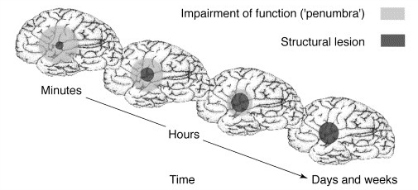As part of the Brain Health Research Centre's annual 'Hot Topic' lecture Dr Andrew Clarkson presented his work in improving potential recovery from stroke. Every year around fifteen million people worldwide will have a stroke. One third of those people will recover fully, one third will be permanently disabled, and one third will die. The chance of stroke doubles for each decade of life after 55, and so as the global population ages the number of people affected by stroke will increase. The current goal of Dr Clarkson and his team is to develop techniques which enable people to recover fully from stroke. He does this by trying to help the cells which are unaffected by the stroke to grow and form new connections, this would allow them to take over some of the function of the damaged area.
A stroke occurs when there is either a bleed in the brain or a blockage in one of the arteries in the brain. An area of the brain will be directly impacted by this, and the cells in that area will quickly die, this area is known as the infarct. There is an area of tissue around the infarct which is also at risk, known as the penumbra. In the days after the stroke the infarct will grow, resulting in the death of more cells within the penumbra. Eventually this pattern of cell death subsides, but it leaves a physical hole in the brain. The cells near to this hole, while still alive and physically unharmed, lose some of their ability to function because the cells they communicated with are now dead. Dr Clarkson's work focuses specifically on these cells.

In theory, if you can increase the connectivity of the remaining cells in this damaged area, then you can reduce the impact that the damage has on the individual. Dr Clarkson wanted to test this theory, and so he used two chemicals in the brains of mice who had had a stroke: BDNF and CX1837. While these chemicals may have complicated names their functions are quite straightforward: they help your brain cells to sprout new connections and make it easier for cells to fire electrical signals that are required in order for brain cells to communicate.
Dr Clarkson examined these animals' motor skills using a series of physical tests before and after the stroke, as well as before and after treatment. He later examined their brains to determine how many new connections had been made. What he found was promising. While young animals consistently recovered to a greater extent than aged animals, the combined use of BDNF and CX1837 improved the motor recovery of all the animals. Dr Clarkson was able to directly relate this recovery to the increased sprouting of connections he saw in these animals brains.
However, Dr Clarkson wasn't happy to just stick with the small improvements he was able to make to these animals recovery. He then systematically determined which pathways these chemicals were using in order to produce the effects he'd observed. This means that in the future he and other researchers can try to maximise the effectiveness of these pathways and increase recovery to an even greater extent.
When it comes to stroke time is the most crucial factor. Rapid medical attention, treatment, and rehabilitation will all reduce the impact of the stroke on your quality of life. The work Dr Clarkson has done extends that window of time. His work provides hope that even if a stroke has severely impacted an individual's life there are things we can do to give them back some of what was lost.
The Brain Health Research Centre would like to extend our sincere thanks to Dr Andrew Clarkson for his time, and we look forward to seeing how his work develops in the coming years.
If you've enjoyed this article, or any of the other work we do here, please consider donating to the Brain Health Research Centre. Your generosity could make a world of difference.
